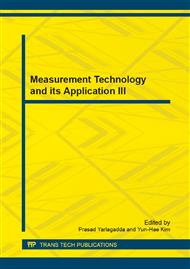[1]
K. Ashia: Earthquake Alarm Systems in Japan Railways. Journal of Japan Association for Earthquake Engineering. Vol. 4 (2004), p.112–117.
DOI: 10.5610/jaee.4.3_112
Google Scholar
[2]
D. Wang and Y. Ni: Wireless Sensor Networks for Earthquake Early Warning Systems of Railway Lines. Journal of Japan Association for Earthquake Engineering, Vol. 148(2012), p.417–426.
DOI: 10.1007/978-3-642-27963-8_38
Google Scholar
[3]
D. Y. Chen, T. L. Lin , Y. M. Wu, and N. C. Hsiao: Testing a P-Wave Earthquake Early Warning System by Simulating the 1999 Chi-Chi, Taiwan, Mw 7. 6 Earthquake. Seismological Research Letters, Vol. 83(2012), p.103–108.
DOI: 10.1785/gssrl.83.1.103
Google Scholar
[4]
Y. M. Wu and L. Zhao: Magnitude estimation using the first three seconds P-wave amplitude in earthquake early warning. Geophysical Research Letters, Vol. 33(2006), pp.1-4.
DOI: 10.1029/2006gl026871
Google Scholar
[5]
G. Grecksch and H. J. Kumpel: Statistical analysis of strongmotion accelerogram and its application to earthquake early-warning systems. Geophysical Journal International, Vol. 129(1997), p.113–123.
DOI: 10.1111/j.1365-246x.1997.tb00940.x
Google Scholar
[6]
N. Shunta, Y. S. Shunroku: New Method for Estimating Earthquake Parameters for Earthquake Early Warning. Quarterly Report of RTRI, Vol. 53 (2012), p.102–106.
DOI: 10.2219/rtriqr.53.102
Google Scholar
[7]
Y. M. Wu, H. Kanamori, R. M. Allen and E. Hauksson: Determination of earthquake early warning parameters, τc and Pd, for southern California. Geophysical Journal International, Vol. 170(2007), p.711–717.
DOI: 10.1111/j.1365-246x.2007.03430.x
Google Scholar
[8]
P. O. Hoyer and A. Hyvärinen: Independent component analysis applied to feature extraction from colour and stereo images. Network (Bristol, England), Vol. 11(2000), p.191–210.
DOI: 10.1088/0954-898x_11_3_302
Google Scholar
[9]
C. Jutten and J. Karhunen: Advances in blind source separation (BSS) and independent component analysis (ICA) for nonlinear mixtures. International journal of neural systems, Vol. 14(2004), p.267–292.
DOI: 10.1142/s012906570400208x
Google Scholar
[10]
A. Hyvärinen, J. Karhunen and E. Oja: Independent Component Analysis (Wiley-Interscience 2001).
Google Scholar
[11]
W. X. Jiang, L. Huang, H. Y. Yu and L. Li, in: A Robust Algorithm for Earthquake Detector of 15th World Conference on Earthquake Engineering (2012).
Google Scholar
[12]
B. F. Zhou, Y. F. Ren, R. Z. Wen, et al: Study on EMD method in strong motion record processing application. Journal of earthquake engineering and engineering vibration. Vol. 33. (2013), pp.9-15.
Google Scholar
[13]
D Boore: Effect of Baseline Corrections on Displacements and Response Spectra for Several Recordings of the 1999 Chi-Chi, Taiwan, Earthquake. Bulletin of the Seismological Society of America. Vol. 91(2001), p.1199–1211.
DOI: 10.1785/0120000703
Google Scholar
[14]
W. Chao, Y. M. Wu, and L. Zhao: An automatic scheme for baseline correction of strong-motion records in coseismic deformation determination. Journal of Seismology, 14(2009), p.495–504.
DOI: 10.1007/s10950-009-9178-7
Google Scholar
[15]
H. C. Chiu: Stable baseline correction of digital strong-motion data. Bulletin of the Seismological Society of America, Vol. 87(1997), p.932–944.
DOI: 10.1785/bssa0870040932
Google Scholar
[16]
R. Wang , B. Schurr, C. Milkereit, Z. Shao, and M. Jin: An Improved Automatic Scheme for Empirical Baseline Correction of Digital Strong-Motion Records. Bulletin of the Seismological Society of America, Vol. 101(2011), p.2029–(2044).
DOI: 10.1785/0120110039
Google Scholar
[17]
H. Y. Yu, W. X. Jiang. Baseline correction of digital strong-motion records in near-field. Journal of Earthquake Engineering and Engineering Vibration, Vol. 29 (2009), pp.1-12. (in Chinese).
Google Scholar
[18]
E. Bingham and A. Hyvärinen: A fast fixed-point algorithm for independent component analysis of complex valued signals. International journal of neural systems. Vol. 10 (2000), p.1–8.
DOI: 10.1142/s0129065700000028
Google Scholar
[19]
A. Hyvärinen and E. Oja: Independent component analysis: algorithms and applications. Neural Networks, Vol. 13(2000), p.411–430.
DOI: 10.1016/s0893-6080(00)00026-5
Google Scholar


